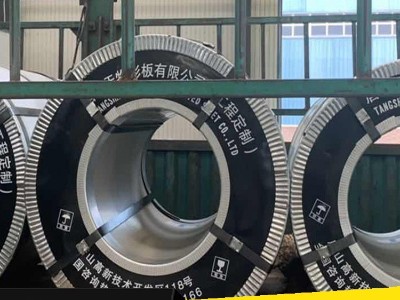河北耐指纹镀锌板厂家的耐指纹处理的原理
天物彩板专注高端彩板定制批发——更多河北耐指纹镀锌彩钢板厂家定制请拨打网站上方电话咨询

由于家用电器的蓬勃发展,镀锌板的表面处理方法多种多样,性能要求也不尽相同。其中,抗指纹处理应用最为广泛。
1) 指纹抵抗的作用
防指纹处理是在镀锌板表面涂一层薄薄透明的有机树脂膜,可以防止操作人员在镀锌板生产过程中的指纹附着在产品上,影响产品外观。同时,还可以提高产品的耐腐蚀性,改善成型过程的润滑性,并可作为后续涂层的粘合基材。
2) 防指纹涂料
钝化后应进行防指纹涂层,使产品具有良好的外观和良好的耐腐蚀性
水溶性树脂种类繁多,如丙烯酸树脂、聚氨酯树脂等,丙烯酸树脂具有色泽浅、透明度高、耐热、耐腐蚀、柔韧性好、加工性好等特点。同时,对镀锌板有很强的附着力。广泛应用于防指纹涂料。聚氨酯树脂耐腐蚀性强,用途广泛。
3) 指纹膜的形成过程
采用辊涂法在镀锌板表面涂覆防指纹涂料。涂料中的有机树脂悬浮在含有微小颗粒的水相中。干燥时,水分逐渐蒸发,体积减小。这些分散的聚合物颗粒逐渐相互接近。颗粒间的毛细管压力迫使颗粒挤压。随着水的蒸发,压力继续增大,使颗粒变形。最后,颗粒相互熔合形成连续的有机薄膜,因此指纹处理后的干燥温度和时间非常重要,否则会导致薄膜固化不良和线圈内镀锌板之间的粘合。一般情况下,膜厚约为1μm,干燥时板温约为110℃,然后冷却至室温进行卷取。
4) 防指纹膜的组成
将防指纹膜分为反应层、浓缩层和润滑层,分别赋予防指纹膜耐腐蚀、润滑、耐指纹、附着力等性能。
将钝化液涂在镀锌板表面并干燥后,将成膜过程分为四个阶段
第一阶段:湿膜涂布:有效成分均匀分散于水介质中;
第二阶段:湿膜中游离水的蒸发;
第三阶段:表面分散剂分离→颗粒融合;
第四阶段:理想成膜状态,结合水/分散剂完全分离,完全交联,颗粒完全熔融。
Due to the blooming of household appliances, there are many kinds of surface treatment methods for galvanized sheet, and the performance requirements are also different. Among them, fingerprint resistant treatment is the most widely used.
1) The role of fingerprint resistance
Fingerprint resistant treatment is to coat a thin and transparent organic resin film on the surface of galvanized sheet, which can prevent the fingerprint of operators from adhering to the product in the production process of galvanized sheet, and affect
the appearance of the product. At the same time, it can also improve the corrosion resistance of the product, improve the lubricity of the forming process, and be used as the adhesive substrate for subsequent coating.
2) Fingerprint resistant coating
The fingerprint resistant coating should be carried out after passivation, so as to make the product have good appearance and good corrosion resistance
There are many kinds of water-soluble resins, such as
acrylic resin, polyurethane resin, etc. Acrylic resin has light color, high transparency, good heat resistance, corrosion resistance, flexibility and processability. At the same time, it has strong adhesion to galvanized sheet. It is widely used in fingerprint
resistant coating. Polyurethane resin has strong corrosion resistance and is widely used.
3) The process of fingerprint film formation
The fingerprint resistant coating is applied on the surface of galvanized sheet by roller coating method.
The organic resin in the coating is suspended in the aqueous phase with tiny particles. When drying, the water gradually evaporates and the volume decreases. These dispersed polymer particles gradually approach each other. The capillary pressure between
the particles forces the particles to squeeze. With the evaporation of water, the pressure continues to increase, which makes the particles deform. Finally, the particles fuse with each other to form a continuous organic film 。 Therefore, the drying temperature
and time after fingerprint treatment are very important, otherwise it will cause the poor curing of the film and the adhesion between the galvanized sheets inside the coil. Generally, the film thickness is about 1 μ m, the plate temperature is about 110
℃ when drying, and then it is cooled to room temperature for coiling.
4) Composition of fingerprint resistant film
The fingerprint resistant film is divided into reaction layer, concentration layer and lubrication layer, which give the anti
fingerprint film corrosion resistance, lubrication, fingerprint resistance, adhesion and other properties respectively.
After the passivation solution was coated on the surface of galvanized sheet and dried, the film forming process was divided
into four stages
Stage I: wet film coating: the effective components are evenly dispersed in the water medium;
Stage II: evaporation of unbound water in wet film;
Stage III: separation of surface dispersant → fusion of particles;
Stage IV: ideal film-forming state, complete separation of bound water / dispersant, full crosslinking and complete fusion of particles.
